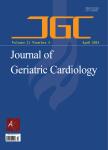Left main coronary stenosis as a late complication of percutaneous angioplasty:an old problem,but still a problem
Left main coronary stenosis as a late complication of percutaneous angioplasty:an old problem,but still a problem作者机构:Division of Cardiac Surgery University of Verona Medical School Verona Italy Interventional Cardiology Unit Division of Cardiology Rovigo General Hospital Rovigo Italy Division of Cardiac Surgery University of Verona Medical School Verona Italy Division of Cardiac Surgery University of Verona Medical School Verona Italy Interventional Cardiology Unit Division of Cardiology Rovigo General Hospital Rovigo Italy Interventional Cardiology Unit Division of Cardiology Rovigo General Hospital Rovigo Italy Division of Cardiac Surgery University of Verona Medical School Verona Italy
出 版 物:《Journal of Geriatric Cardiology》 (老年心脏病学杂志(英文版))
年 卷 期:2009年第6卷第1期
页 面:26-30页
核心收录:
主 题:angioplasty coronary angiography surgery interventional coronary artery disease
摘 要:Objective Accelerated left main coronary stenosis (LMCS) is a known potential late complication of coronary artery catheter procedures. The aim of this study was to assess the current occurrence of LMCS as a delayed complication of percutaneous angioplasty (PTCA) of the left coronary branches in our institution. Methods The medical records of patients referred for coronary artery by-pass surgery from the same Cardiology Unit in the January 2003 to December 2006 period and presenting a significant ( 50%) LMCS as a new finding following a PTCA of the left coronary artery branches, were reviewed. Patients with retrospective evidence of any LMCS at previous coronary angiographies preceding the percutaneous procedure were excluded. Results Thirty-seven patients (5 females, mean age 71.1±8.6 years) out of 944 (4%) having undergone a PTCA, fulfilled the inclusion criteria, 19 (51%) after a procedure also involving the LAD coronary artery. Extraback-up guiding catheters were used in most cases. Use of multiple wires or balloons was observed in 3 cases (8%). Rotablator and proximal occlusion device were used in one case respectively (3%). Twenty patients (54%) have had more than one percutaneous coronary intervention on the left coronary branches. The mean time elapsed from the first angioplasty and surgical intervention was 18.1±7.8 months. Conclusions The potential occurrence of LMCS following a percutaneous intervention procedure, especially when complicated and repeated, should not be underestimated in the current era. This evidence may offer the rationale to schedule non-invasive imaging tests to monitor left main coronary patency after the procedure as well as to fuel further research to develop less traumatic materials.



